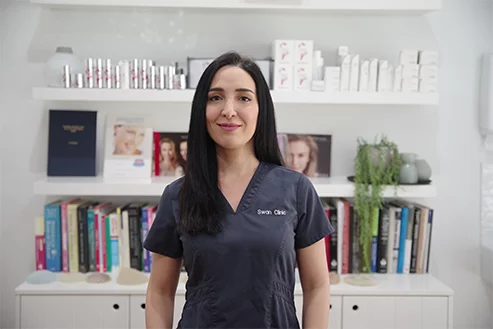BROW LIFT
Brow lift plastic surgery from Dr Reema Hadi in Sydney
A Brow Lift, also known as a forehead lift or browplasty, is a surgical procedure designed to address sagging or drooping eyebrows and forehead wrinkles. As we age, the skin loses elasticity, and the muscles responsible for holding the brow in its youthful position can weaken, causing the eyebrows to descend and creating an aged or tired appearance.
Brow Lift surgery elevates the position of the eyebrows and smoothens the forehead skin, resulting in a more youthful and rejuvenated look. This procedure can also address deep forehead furrows, frown lines, and the vertical lines between the eyebrows.
ALSO KNOWN AS: Forehead Lift, Browplasty, Browlift
Types of Brow Lift
- Traditional Brow Lift (Coronal Brow Lift): A classic approach where an incision is made across the scalp's top, camouflaged within the hairline. This method provides extensive forehead rejuvenation but might necessitate a longer recovery period.
- Temporal or Limited Incision Brow Lift: Focusing on the eyebrows' outer area, this technique uses incisions at the hairline above the temples. It's best for those requiring a mild lift.
- Direct Brow Lift: This addresses significant brow drooping by making an incision just above the eyebrows. The technique is more favorable for men with bushy eyebrows.
- Mid Forehead Lift (Pretrichial Brow Lift): Suitable for those with notable central forehead sagging, the incision is made at the hairline.
Am I a Candidate for a Brow Lift?
While a detailed consultation with our experienced plastic surgeon is essential, good candidates generally:
- Experience sagging or drooping eyebrows that lead to an aged or tired look.
- Wish to rectify forehead wrinkles, frown lines, or furrows.
- Maintain good health without any hindering medical conditions.
In Summary
A Brow Lift can rejuvenate and provide a youthful appearance. The variety of Brow Lift techniques ensures tailored treatments for each patient. In a comprehensive consultation with Dr Hadi, we'll analyze your facial characteristics, discuss aspirations, and suggest the optimal Brow Lift method for you. Our adept team is committed to offering individualized care and delivering authentic results. To begin your journey to a rejuvenated self, contact us for a consultation.
LATEST SURGICAL BROW LIFT TECHNIQUES
In the 1980s, the brow lifts were overdone resulting in the startled look. We now restore the tissues to their rightful place rather than over elevating them. Our improved knowledge of anatomy and long-term study of patients had led to improved outcomes for our patients through modern surgical techniques.
Postoperative care is a crucial aspect of any Brow Lift procedure to ensure proper healing, minimize complications, and achieve optimal results. Here are some general guidelines for postoperative care after a Brow Lift surgery:
- Rest and Recovery: Dedicate time for recuperation. Avoid work and intense activities for at least 1 to 2 weeks.
- Pain Management: Discomfort and swelling are typical post-surgery. Your surgeon will prescribe pain relievers for initial recovery stages.
- Head Elevation: Elevate your head to minimize swelling. Use extra pillows or a reclining chair for the first few days.
- Cold Compresses: Cold compresses or ice packs can reduce swelling and bruising. Avoid direct ice contact with incisions.
- Dressings and Incision Care: Abide by your surgeon's wound care instructions. Dressings or bandages will be removed during follow-ups.
- Avoid Strenuous Activities: Avoid any activity causing strain or elevating blood pressure for several weeks.
- Avoid Smoking and Alcohol: These substances can hinder the healing process.
- Follow a Healthy Diet: A balanced diet aids in the healing process.
- Medication Management: Take any prescribed antibiotics or medications as directed.
- Attend Follow-Up Appointments: Regularly see your surgeon for monitoring and guidance.
- Avoid Sun Exposure: Shield incisions from direct sun. Use hats and sunscreen (after surgeon approval) for outdoor activities.
- Be Patient: Final Brow Lift results might take weeks to manifest fully. Swelling and bruising will decrease over time.
It's vital to strictly adhere to your surgeon's postoperative guidelines, as recovery varies based on surgical techniques and individual circumstances. Proper postoperative care ensures smooth recovery and successful results from your Brow Lift surgery.
Bandages and Dressings After Brow Lift Surgery
Bandages and dressings are essential components of postoperative care following a Brow Lift surgery. Depending on the surgical method and surgeon's recommendations, the type and duration of these coverings might differ. Here's a guide on what to expect:
- Dressings Immediately After Surgery: Post-surgery, sterile dressings or bandages will cover the incision areas. These protect the wounds, manage swelling, and soak up any initial discharges.
- Compression Garments: Some patients might be advised to wear a compression garment or head wrap, which exerts gentle pressure on the operated area. This assists in reducing swelling and promoting healing.
- Changing Dressings: Strictly adhere to your surgeon's guidelines on dressing replacements to ensure the surgical site remains sterile and clean.
- Keeping Incisions Dry: It's imperative to avoid wetting the incisions until permitted by your surgeon. This might entail avoiding showers temporarily.
- Suture Removal: If non-dissolvable sutures were used, a subsequent appointment would be set for their removal, usually a week or two post-surgery.
- Incision Care: Specific care instructions will be given for your incisions. This might include cleaning methods and any topical treatments.
- Gradual Removal: Depending on your healing progression, your surgeon might decrease the frequency or need for bandages or dressings.
- Scar Management: Once your incisions heal, various scar management techniques like silicone gel or sheets may be suggested to enhance scar appearance over time.

